The OCZ Vertex 3 Review (120GB)
by Anand Lal Shimpi on April 6, 2011 6:32 PM ESTAnandTech Storage Bench 2011
I didn't expect to have to debut this so soon, but I've been working on updated benchmarks for 2011. Last year we introduced our AnandTech Storage Bench, a suite of benchmarks that took traces of real OS/application usage and played them back in a repeatable manner. I assembled the traces myself out of frustration with the majority of what we have today in terms of SSD benchmarks.
Although the AnandTech Storage Bench tests did a good job of characterizing SSD performance, they weren't stressful enough. All of the tests performed less than 10GB of reads/writes and typically involved only 4GB of writes specifically. That's not even enough exceed the spare area on most SSDs. Most canned SSD benchmarks don't even come close to writing a single gigabyte of data, but that doesn't mean that simply writing 4GB is acceptable.
Originally I kept the benchmarks short enough that they wouldn't be a burden to run (~30 minutes) but long enough that they were representative of what a power user might do with their system.
Not too long ago I tweeted that I had created what I referred to as the Mother of All SSD Benchmarks (MOASB). Rather than only writing 4GB of data to the drive, this benchmark writes 106.32GB. It's the load you'd put on a drive after nearly two weeks of constant usage. And it takes a *long* time to run.
I'll be sharing the full details of the benchmark in some upcoming SSD articles but here are some details:
1) The MOASB, officially called AnandTech Storage Bench 2011 - Heavy Workload, mainly focuses on the times when your I/O activity is the highest. There is a lot of downloading and application installing that happens during the course of this test. My thinking was that it's during application installs, file copies, downloading and multitasking with all of this that you can really notice performance differences between drives.
2) I tried to cover as many bases as possible with the software I incorporated into this test. There's a lot of photo editing in Photoshop, HTML editing in Dreamweaver, web browsing, game playing/level loading (Starcraft II & WoW are both a part of the test) as well as general use stuff (application installing, virus scanning). I included a large amount of email downloading, document creation and editing as well. To top it all off I even use Visual Studio 2008 to build Chromium during the test.
Update: As promised, some more details about our Heavy Workload for 2011.
The test has 2,168,893 read operations and 1,783,447 write operations. The IO breakdown is as follows:
| AnandTech Storage Bench 2011 - Heavy Workload IO Breakdown | ||||
| IO Size | % of Total | |||
| 4KB | 28% | |||
| 16KB | 10% | |||
| 32KB | 10% | |||
| 64KB | 4% | |||
Only 42% of all operations are sequential, the rest range from pseudo to fully random (with most falling in the pseudo-random category). Average queue depth is 4.625 IOs, with 59% of operations taking place in an IO queue of 1.
Many of you have asked for a better way to really characterize performance. Simply looking at IOPS doesn't really say much. As a result I'm going to be presenting Storage Bench 2011 data in a slightly different way. We'll have performance represented as Average MB/s, with higher numbers being better. At the same time I'll be reporting how long the SSD was busy while running this test. These disk busy graphs will show you exactly how much time was shaved off by using a faster drive vs. a slower one during the course of this test. Finally, I will also break out performance into reads, writes and combined. The reason I do this is to help balance out the fact that this test is unusually write intensive, which can often hide the benefits of a drive with good read performance.
There's also a new light workload for 2011. This is a far more reasonable, typical every day use case benchmark. Lots of web browsing, photo editing (but with a greater focus on photo consumption), video playback as well as some application installs and gaming. This test isn't nearly as write intensive as the MOASB but it's still multiple times more write intensive than what we were running last year.
As always I don't believe that these two benchmarks alone are enough to characterize the performance of a drive, but hopefully along with the rest of our tests they will help provide a better idea.
The testbed for Storage Bench 2011 has changed as well. We're now using a Sandy Bridge platform with full 6Gbps support for these tests. All of the older tests are still run on our X58 platform.
AnandTech Storage Bench 2011 - Heavy Workload
We'll start out by looking at average data rate throughout our new heavy workload test:
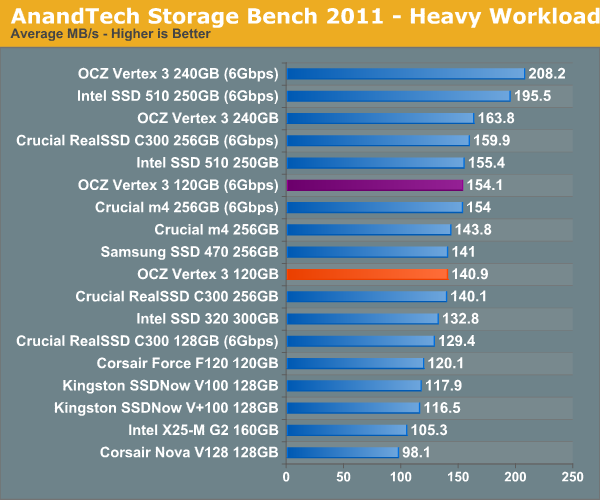
In our heavy test for 2011 the 120GB Vertex 3 is noticeably slower than the 240GB sample we tested a couple of months ago. Fewer available die are the primary explanation. We're still waiting on samples of the 120GB Intel SSD 320 and the Crucial m4 but it's looking like this round will be more competitive than we originally thought.
The breakdown of reads vs. writes tells us more of what's going on:

Surprisingly enough it's not read speed that holds the 120GB Vertex 3 back, it's ultimately the lower (incompressible) write speed:
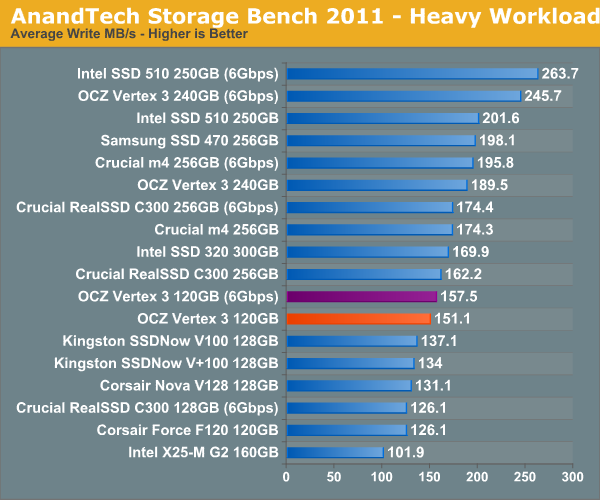
The next three charts just represent the same data, but in a different manner. Instead of looking at average data rate, we're looking at how long the disk was busy for during this entire test. Note that disk busy time excludes any and all idles, this is just how long the SSD was busy doing something:
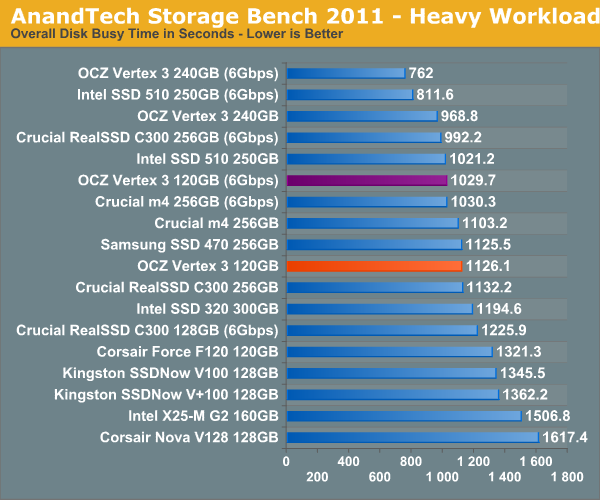
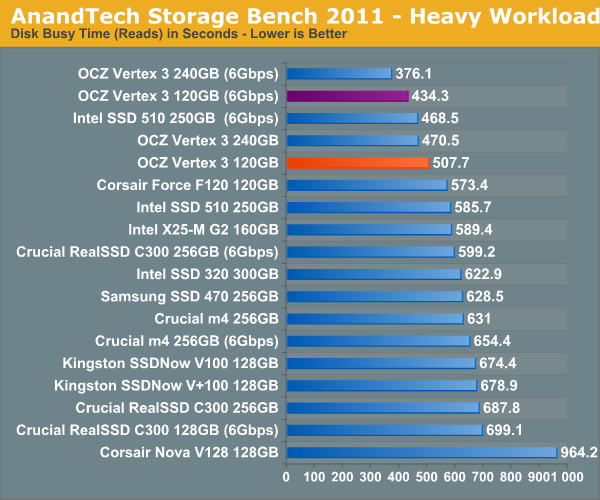
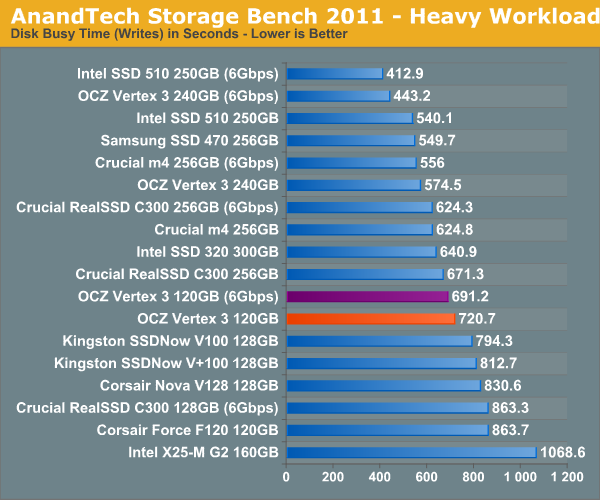










153 Comments
View All Comments
Super - Friday, April 8, 2011 - link
...perhaps the Nobel Peace Prize. ?? i've seen someone win it for a whole lot less *cough ObamaA5 - Wednesday, April 6, 2011 - link
Agreed - glad they listen to Anand.The real question is why they didn't do anything until Anand bitched to the CEO directly. It's not like they weren't aware of the issue - the Storage Review article came out several months ago...
darckhart - Wednesday, April 6, 2011 - link
It just goes to show that companies are not customer focused. Unless they get shoved hard enough, or see that the bottom line will be affected greatly, they just hope you'll give up after being mired in the revolving email chain or sent through 5 level deep phone support.Thanks Anand for reminding companies that some of us are still capable of making informed decisions and aren't afraid to express our dissatisfaction with our dollars.
789427 - Thursday, April 7, 2011 - link
It's not about being customer focussed or not. Quite frankly, what percentage of upgraders will go into this level of detail?Furthermore, 25nm sounds better than 35nm to most people and that's salesmen included.
After all that, it's a victory for transparency for a tiny few.
In terms of marketing, there's little you can do except re-brand the entire product range.
e.g. Silver and Silver Pro for the lower capacities, Gold and Gold Pro for the higher capacities and explain on the box that fewer chips means generally lower performance
The problem here is that this is the cutting edge of technology and that in 12 months time, it will be surpassed. Then how do you re-vamp the line?
Graphics cards have this problem too and the model numbers are baffling for 99% of first-time buyers.
What I would advocate is a sticker valid for 3 months on the product that lets you know which product in terms of performance you are buying and a URL you can visit to check for an update.
e.g.
Your product: xyz 300-35
is better than xyz 300-24
but is worse than 300-ii
Check Real performance figures here: URL
Then it would be nice for salesmen to allow customers to verify this.
cb
cactusdog - Wednesday, April 6, 2011 - link
Yep, at least OCZ have made a commitment not to use slow hynix nand and are being more transparent with real world performance but its all too little too late.Branding drives with the 25 or 34nm prefix is redundant now that all(or most) nand being produced is 25nm. Ocz made no real attempt to fix the problem when they needed to, and continued to sell the drives even after the consumer backlash.
I disagree with Anand that other manufacturers of sandforce controller drives hide the specs as OCZ did. Corsair rebranded their 25nm drives from the start. Other non sandforce drives from Intel also rebranded their 25nm drives.
Its true that many companies use different components and use the same branding but rarely does the performance vary as much as 30%. 30% is a huge and not acceptable for high end expensive parts..
Its a pity Anand didnt really have anything to add on the Spectek issue that hasnt already been said. I find it hard to believe a company like Micron would sell very expensive nand cheaper to Spectek unless there is some problem with it.
Saying Spectek nand must be OK because it is still rated at 3000 cycles doesnt sound very thorough or tell us the whole story. The cycle rating could have very different testing standards between Micron and Spectek.
I would have thought it would be easy for someone like Anand to ask Micron or Spectek if the Spectek nand is tier 1 nand or not. I wouldnt trust OCZ response given their track record.
Overall though thanks Anand for sticking up for the consumers.
Powerlurker - Wednesday, April 6, 2011 - link
According to their corporate website "SpecTek began at Micron in 1988 as a component-recovery group." which would lead me to believe that they're Micron's low-end brand for disposing of lower performing dies.Xneb - Thursday, April 7, 2011 - link
That is correct. testing is the same though so end users should not be able to tell the difference between spectek and imft nand in these drives.sleepeeg3 - Thursday, April 7, 2011 - link
You can't fault him for reporting honestly. There is no concrete data that shows Spectek NAND is inferior to Micron.Alkapwn - Wednesday, April 6, 2011 - link
Ditto! Keep up the great work! We all appreciate it greatly!Mr Perfect - Thursday, April 7, 2011 - link
Yes, thank you for addressing the Vertex 2 issue.The sad part is that if OCZ had used their new, transparent labeling scheme from day one, they would have been praised for their transparency and all of the other companies would have been expected to rise to their standard. Instead, they waited through months of consumer and press outcry, meaning this fair and honest SKU system is merely re-earning lost trust.